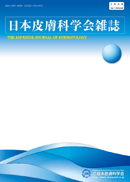All issues

Volume 121, Issue 14
Displaying 1-9 of 9 articles from this issue
- |<
- <
- 1
- >
- >|
Guidelines
-
Article type: Guidelines
2011 Volume 121 Issue 14 Pages 3279-3306
Published: December 20, 2011
Released on J-STAGE: November 13, 2014
JOURNAL FREE ACCESSDownload PDF (1054K)
Seminar for Medical Education
-
[in Japanese]Article type: Seminar for Medical Education
2011 Volume 121 Issue 14 Pages 3307-3312
Published: December 20, 2011
Released on J-STAGE: November 13, 2014
JOURNAL RESTRICTED ACCESS -
[in Japanese]Article type: Seminar for Medical Education
2011 Volume 121 Issue 14 Pages 3315-3320
Published: December 20, 2011
Released on J-STAGE: November 13, 2014
JOURNAL RESTRICTED ACCESSDownload PDF (443K) -
[in Japanese]Article type: Seminar for Medical Education
2011 Volume 121 Issue 14 Pages 3323-3329
Published: December 20, 2011
Released on J-STAGE: November 13, 2014
JOURNAL RESTRICTED ACCESSDownload PDF (2202K)
Original Articles
-
Azusa Hiruma, Tomoko Kojima, Emiko Akasaka, Masayuki Kato, Norihiro Ik ...Article type: Original Articles
2011 Volume 121 Issue 14 Pages 3331-3336
Published: December 20, 2011
Released on J-STAGE: November 13, 2014
JOURNAL RESTRICTED ACCESSA 34-year-old man was treated for depression with several antidepressants. He developed a high fever and edematous erythema and papules over his entire body. Facial swelling and lymph node swelling were observed. Leukocytosis with eosinophilia, atypical lymphocytes, and liver dysfunction were also present. He was diagnosed with DIHS, and therapy was started with methylprednisolone hemisuccinate 120 mg/day. His condition improved gradually, but recurrences of symptoms such as high fever, erythema, and hepatopathy were observed many times as we decreased the steroid dose. Reactivation of herpes viruses (human herpes virus 6 and 7) was observed as well. He was administrated intravenous immunoglobulin, steroid pulse, and ganciclovil. He is still taking prednisolone 25 mg/day after two years because of recurrences. We discussed this case with reference to former studies.View full abstractDownload PDF (987K) -
Daisuke Kabata, Hideaki Tanizaki, Akiko Arakawa, Miki Tanioka, Shunji ...Article type: Original Articles
2011 Volume 121 Issue 14 Pages 3337-3342
Published: December 20, 2011
Released on J-STAGE: November 13, 2014
JOURNAL RESTRICTED ACCESSAn 11-year-old boy developed a painless erythematous nodule on the right forearm, which gradually became ulcerated and slightly painful. Although the ulcerated nodule was removed at a nearby hospital, the patient developed another ulcer and visited our department in April of 2010. A skin biopsy specimen from the ulcer bed showed numerous acid-fast bacilli in the subcutaneous tissue. The biopsied specimen was subjected to DNA analysis, and the result was compatible with M. ulcerans subsp. shinshuense; the patient was diagnosed with Buruli ulcer. After 6 weeks of incubation in 2% Ogawa egg medium slants and Mycobacterium Growth Indicator Tube, the culture yielded yellow colonies. Two months after starting rifampicin and clarithromycin, the cutaneous ulcer was surgically removed and covered by skin grafting. The patient continued the antibiotics for 6 months, and there was no recurrence in the following 1 month. Buruli ulcer is caused by Mycobacterium ulcerans, one of the nontuberculous mycobacteria that are present in tropical countries. However, very recently, cases of Mycobacterium ulcerans subsp. shinshuense infection have frequently been reported from Japan. Thus, this disease should be considered in the differential diagnosis of a chronic skin ulcer.View full abstractDownload PDF (831K) -
Yusuke Shirakashi, Makoto Sugiura, Atsushi Fujimoto, Mariko KamoArticle type: Original Articles
2011 Volume 121 Issue 14 Pages 3343-3348
Published: December 20, 2011
Released on J-STAGE: November 13, 2014
JOURNAL RESTRICTED ACCESSSeven patients with severe atopic dermatitis, including 6 males and 1 female, were enrolled in the study. The average age was 35 years. We administered cyclosporine microemulsion (Neoral®) at 1.1~1.9 mg/kg once before breakfast, and measured the serum cyclosporine level at 1, 2, and 4 hours after dosing (C1~C4). In most patients, rapid improvement of skin manifestations was achieved, with 38~65% (average 51%) improvement of the Japanese Dermatological Society Atopic dermatitis severity score within 2 weeks. No side effects such as elevated blood pressure or serum creatinine level occurred. In all cases, Tmax was an hour later after dosing. The Cmax was 768~1,379 (average 1,010) ng/ml. These results suggest that therapy with low dose cyclosporine once daily can reduce side effects, and it also is a useful regimen in terms of cost effectiveness.View full abstractDownload PDF (695K) -
Fumiko Oda, Koji Sayama, Mikiko Tohyama, Koji HashimotoArticle type: Original Articles
2011 Volume 121 Issue 14 Pages 3349-3353
Published: December 20, 2011
Released on J-STAGE: November 13, 2014
JOURNAL RESTRICTED ACCESSA 14-year-old Japanese girl presented with complaints of the archetypal thigh, abdomen hyperpigmentation, induration, hypertrichosis, and congenital bilateral hearing loss. The maternal grandmother and paternal grandfather were cousins. This patient had been previously reported as a morphea profunda, but was revealed to be the first recorded case of H syndrome in Japan. The H syndrome (OMIM #612391) is a recently characterized autosomal recessive disorder caused by mutations in SLC29A3, which encodes the human equilibrative nucleoside transporter 3 (hENT3). Mutation analysis revealed a novel homozygous missense mutation, c.552C>G.View full abstractDownload PDF (943K)
Abstracts
-
2011 Volume 121 Issue 14 Pages 3355-3454
Published: 2011
Released on J-STAGE: November 13, 2014
JOURNAL RESTRICTED ACCESSDownload PDF (18925K)
- |<
- <
- 1
- >
- >|